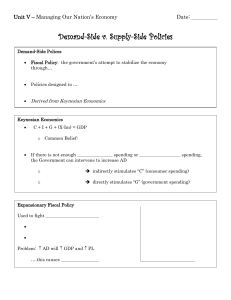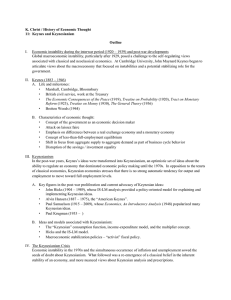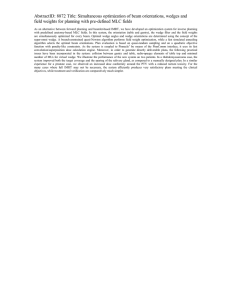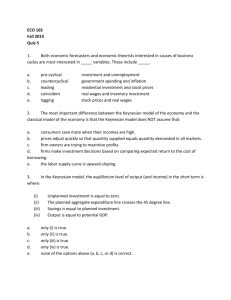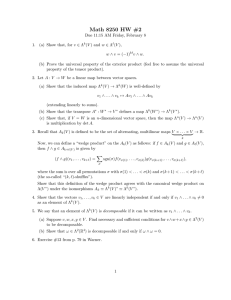Supply-Side Economics Economics at Klein Oak High School Fall 2003
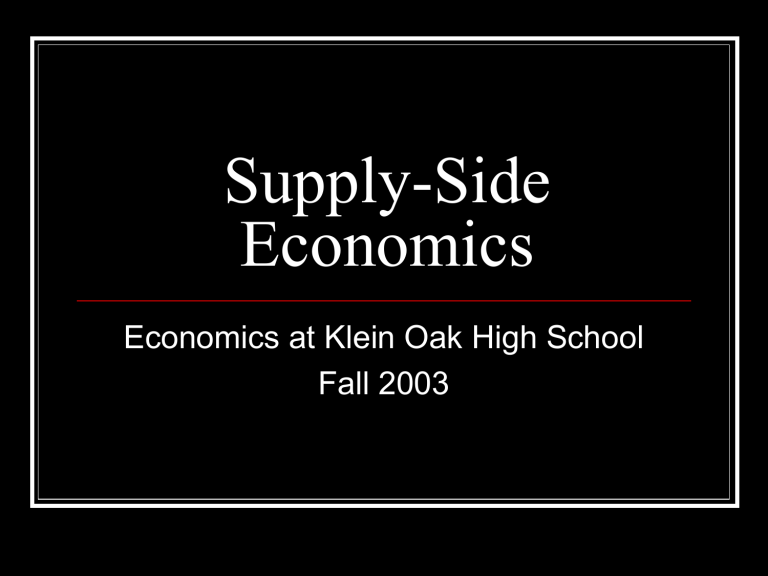
Supply-Side
Economics
Economics at Klein Oak High School
Fall 2003
Review Keynesian Economics
focus on demand side
aggregate demand (AS) management
C+I+G+(Ex-Im)=GDP
Keynesian Recession Strategy
increase AD
increase G (government spending)
government spends more
increase C (consumption)
decrease taxes (fiscal policy)
increase money supply (monetary policy)
Keynesian Inflation Strategy
decrease AD
decrease G (government spending)
government spends less
decrease C (consumption)
increase taxes (fiscal policy)
decrease money supply (monetary policy)
Supply Side Perspective
stagflation is different
caused by decrease in AS (aggregate supply)
because lower supply lower output (GDP) and higher prices (inflation)
Cause of Decrease in AS
government policy (unintended consequences)
high taxes
discourage business investment
“tax wedge” decreases after tax rate of return
decrease savings
same reason
causes higher interest rate decreases business investment
Note on “Tax Wedge”
difference between what is paid and what is received
ex: to pay $5.50 to an employee costs a business $7.00, due to taxes
after taxes, the employee receives $4.50
difference between $7.00 cost to business and
$4.50 incentive to employee is the “tax wedge”
Cause of Decrease in AS (2)
government policy (unintended consequences)
high taxes
discourage work
“tax wedge” increases after tax cost to business
“tax wedge” decreases after tax return to employee
therefore, employment decreases and so does production
Cause of Decrease in AS (3)
government policy (unintended consequences)
excessive regulation
increases cost of production decreases supply
supply shock
little can be done about this but it isn’t a long run problem
Supply Side Goal
Supply Side Policy
increase AS
reduce taxes on business
reduce regulation on business
reduce taxes on savers
people with a high “marginal propensity to save”
i.e. people who save additional dollars
primarily high income people
The Laffer Curve
after a point the disincentive effect of higher tax rates will result in high rates reducing tax revenue
more
Implications of Laffer Curve
it’s possible to raise rates and get less revenue
the higher rates cause a “recession”
it’s possible to lower rates and get more revenue
if the lower rates stimulate the economy enough
Tax Fairness
tax cuts will give more $ to wealthy than to others because
wealthiest 50% pay 96% of income taxes
wealthiest 5% pay 53% of income taxes
Short-run vs . Long-run
Keynes: “In the long run we are all dead.”
Keynes ignored the long run complications of the policies he advocated.
Of course, it was the great depression.
Supply-side policies focus on the long run
emphasis on incentives
requires that people and businesses can depend on policies remaining in force for years
Effect of Supply–Side Ideas
Most economists still primarily Keynesian.
However, most now acknowledge that we must consider the supply-side effects of our policies.
Recommendations are now more long-run in perspective.

